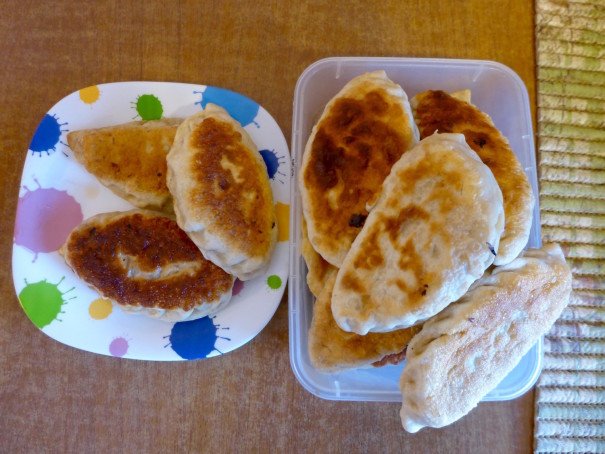
Dumplings Made of Meat, Flour, and Not Much Else

Dumplings Made of Meat, Flour, and Not Much Else
Khuushuur in Ulaanbaatar
It’s 9 am in Ulaanbaatar and my host mum Uka is chopping meat on the small kitchen table. The blade of the knife slices through the frozen mutton and thumps the wooden chopping board below.
I’ve just got up and am nursing a cup of dissolvable antibiotics and orange squash. Through the window at the end of the kitchen I can see the brown smog swirling around the buildings; it’s that air pollution which has given me a dose of conjunctivitis and a hacking cough. In the winter months, the city has one of the highest levels of air pollution in the world.
Uka, who has just come back from a yoga class, is making khuushuur—fried dumplings—for us to take on a picnic later today. I’ve been staying with her for almost a month and she wants to show me there is more to Mongolia than that capital city.
She takes out lumps of icy sheep meat from the freezer and defrosts them in the oven. The mutton is left over from the Lunar New Year festival, Tsagaan Sar, two weeks ago, and we’ve been struggling to eat it all since. The sheep’s head, stomach, and bones are outside in bags, frozen at -20 degrees, on the balcony. The winter weather is far more effective—and the balcony much bigger—than Uka’s freezer.
She shakes a large amount of flour into a bowl, adds water, then kneads the mixture into dough. She pushes it around the pink pearlescent plastic bowl with her hands before dividing it into six lumps. She rolls each dough ball out with a rolling pin and spoons the filling of chopped mutton and cabbage into the center. Then she folds the dough over on itself and crimps the edges to make it hold. At the end she has too much meat left and makes a giant dumpling we nickname “the fat one” while giggling.
By the stove, her 14-year-old daughter is already frying the first batch. When they have turned brown on both sides she transfers them to a plastic container on the worktop, where they send up spirals of steam.
Uka and her daughter leave the kitchen to get changed and I’m told to help myself to the golden parcels for breakfast.
I take my first bite: the dough is tough but tasty, the meat tender and the cabbage soft. The fat from the meat spills out, runs down my hand and onto the tabletop.
Dumplings made of meat, flour, and not much else have been eaten for centuries in Mongolia, a country which traditionally can’t grow much produce because of the harsh winters, which can drop to -40 and lower.
We drive 60 miles west through valleys lined with snow-covered mountains along good roads, bad roads, and finally no roads at all to a Buddhist temple. The sky is blue and clear, the snow so white it makes the clouds look grey. The golden roofs of the temples gleam in the sunlight. I’m made to climb through a rock called “mother’s womb” to get reborn.
It’s wonderful to be able breath in clean air again.
Later, driving home, we pull up by the side of the road and eat our picnic. I’m sitting in the passengers seat in the front of the car and through the windscreen all I can see is white and blue.
The dumplings are still warm and just as delicious, but this time the view is much better.